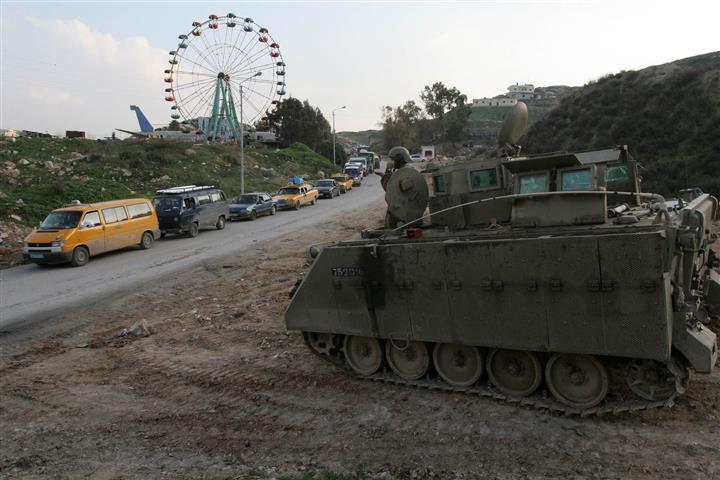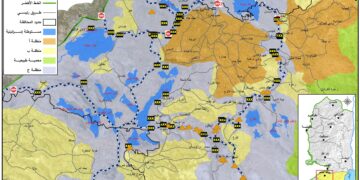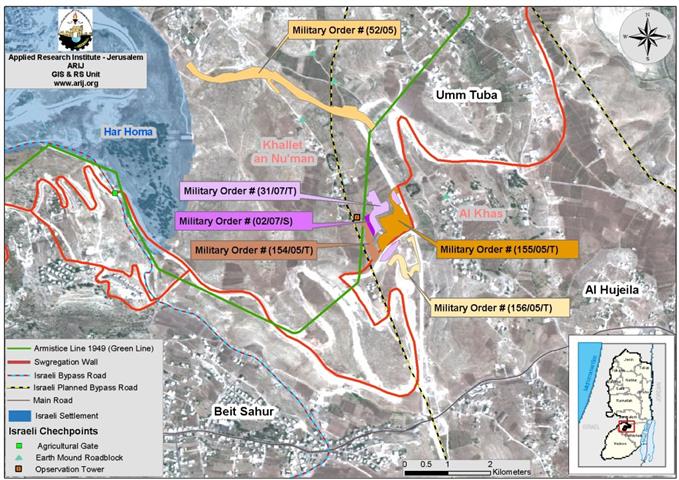(Photo 1: Wadi Al Badan, Nablus: an Israeli armored personnel carrier blocking the Al Badan road)
Location and strategic importance
Al Badan Road is located in a strategic position in the West Bank as it connects the Jordan Valley rift in the east with the mountainous central region of the West Bank and the Palestinian coast on the Mediterranean Sea in the west. It, also, connects the northern parts of the West Bank -The governorates of Jenin and Tubas- with the rest of the West Bank through the Governorate of Nablus. See Map 1
The history of the Road dates back as early as the Ottoman era when it used to be an unpaved agricultural road used for commercial purposes and to connect between east and west of the Jordan River. During the British Mandate the road was paved and used to transport military hardware as well as British soldiers to Palestine. It was enlarged during the Jordan era to become the connecting road between the Emirate of East Jordan and the Palestinian centers west of the River. The Road was also used as the main road used by Palestinians fleeing the West Bank in the aftermath of the Six Day War of 1967.
The Israeli Occupation and Al Badan Checkpoint
Since its occupation of the West Bank in 1967, Israeli forces placed a great deal of importance to Al Badan Road. Throughout the years permanent and flying checkpoints have been placed on the Road in addition to the establishment of military towers along both sides of it. Since the eruption of the Second Intifada, Israeli occupation forces have been trying to tighten its grip on the West Bank and to lay siege to the Palestinian cities especially the City of Nabuls. In order to do so, Israeli forces established permanent checkpoints at the main intersections connecting between Palestinian cities and governorates. Similar checkpoints and road barriers were also placed at the entrances of major cities throughout the West Bank. The number of these checkpoints and road barriers (in all of threir different forms) has reached 567 (according to LRC statistics) including Al Badan checkpoint.
(Map 2: Israeli closures around Nablus city)
Al Badan checkpoint is located 9 kilometers south east of the City of Nablus. It is one of the ten checkpoints surrounding the city from all of its different directions as to tighten the occupation grip on it. These checkpoints have led to the near total destruction of Nablus’s economy after it used to be the capital of Palestinian economy before the events of the recent Intifada.
Effects of Al Badan Checkpoint
A) Economic Dimension
The establishment of Al Badan checkpoint has severely affected negatively the commerce in the city as it led to measurable difficulties in transporting commercial commodities into and out-of the city. Especially affected was the trade of transporting the vegetables from the Jordan Valley towards the city which negatively affected the economy of the city and the entire region in general. The checkpoint has, also, made it extremely difficult to supply the city with the different goods which has led to an increase in poverty, unemployment rates and an overall economic depression. Such a fact is reflected in statistics provided by the Nablus Chamber of Commerce that indicated that the average daily losses sustained by the city has reached NIS 6 million due to the tight closures set around it by the Israeli occupation forces.
In addition to what was stated above, Al Badan checkpoint, along with the strict Israeli procedures associated with it, has led to the slow death of the tourism industry in the area of Al Badan. Such an area is known throughout the West Bank for its tourist attractions due to the presence of a large number of cold water springs, forests, restaurants, pools as well as rest areas that are owned by Palestinian families from the villages of Al Badan, Talouza and Al Fara’a. The establishment of Al Badan checkpoint has prevented tourist convoys, along with others, from venturing into the city which led to the closure of a large number of commercial shops and restaurants and rendered tens of families deprived of their only source of income.
Al Badan checkpoint has many victims including Mr. A’asi Isma’il Dababsa from the village of Talouza who invested a large sum of money to establish a restaurant in Al Badan area. Due to the large losses encountered after the establishment of the checkpoint, Mr. Dababsa ended up shutting down the business.
B) Social and Health Dimensions
The social by-products of the checkpoint manifests itself in the long lines of vehicles especially under the heat of the sun and the cold winter mornings in addition to controlling the entry and exit of Palestinians in accordance with the mood of the soldiers manning the checkpoint. These manifestations became more apparent since the beginning of June 2007 when Israeli occupation forces manning the checkpoint started to prevent Palestinians less than 35 years old from crossing the checkpoint. That is in addition to delaying Palestinians and making them wait in long lines for a distance up to 2 kilometers. On the 9th of June Israeli soldiers manning the checkpoint delayed an ambulance for a long period of time which led to the death of the 25-year-old Zaid Sa’id Al Sayeh after he drowned in one of the swimming pools in the region. The soldiers showed carelessness and ignored the essence of time in such an emergency. Once he reached the hospital, all attempts taken by the doctors in the Nablus city hospital to restitute him failed. Medical reports indicated that it was possible to save the life of the young man if the medications were given to him in the appropriate time; the distance between the city of Nablus and Al Badan area can be covered within 25 to 30 minutes. Yet, the Israeli soldiers delayed the ambulance to the degree that any attempt to revive his life was fruitless.
(Photo 2: Wadi Al Badan, Nablus: a long line of vehicles waiting to cross the checkpoint )
A similar incident was that of the 57-year old Ahmad Al Mut’eb of Al Badan village who needed to clean his kidneys in Rafeedia Hospital in Nablus regularly. His death took place after he was turned away by the Israeli soldiers manning the checkpoint despite his serious condition. He passed away few hours after came back home. As a result of this policy, a large number of the employees working in Al Badan area were forced to live in the City of Nablus out of fear of losing their jobs.
Alternative Roads
Palestinians denied access through Al Badan checkpoint usually use alternative roads to enable them to reach their destinations. Such roads include:
-
Middle Jordan Valley Road – Al Hamra checkpoint, Za’atara checkpoint and then to Nablus City. The distance covered through this route is almost three times longer than the regular distance covered if one was to use the regular Al Badan Road.
-
Bilal Mountain Road which leads to the area of Beit Forik and Deir Al Hatab villages and then to the City of Nablus.
-
The road connecting the villages of north west Nablus City including Sabastya, Al Naqura, Jansinya and Asira Al Shamaliya.
Shut Down of the Checkpoint
In the period between 2001 and 2005 Israeli forces completely shut down the checkpoint in the face of Palestinian traffic coming from the governorates of Jenin and Tubas while allowing Palestinian residents of nearby Al Badan and Al Fare’a villages to cross the checkpoint. This situation has forced thousands of Palestinians from the afore-mentioned two governorates to use alternative roads that are lengthier, more tiring and more expensive.
Prepared by
The Land Research Center
LRC

















